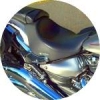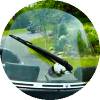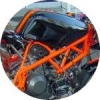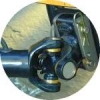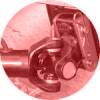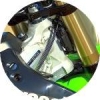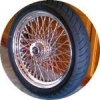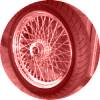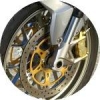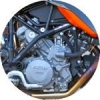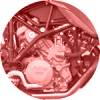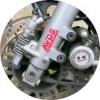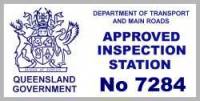Queensland Department of Transport and Main Roads introduced the safety certificate in November 1999 to replace the old roadworthy certificate or RWC, and it became
mandatory to obtain and display a current safety certificate on any registered motorcycle from the moment it's offered for sale.
The only times it's not required to display current safety certificate on a motorcycle for sale is when the motorcycle's either unregistered or is traded to or
between licensed motor dealers.
Queensland Department of Transport and Main Roads safety certificates can only be issued by Approved Inspection Stations (AIS), being service stations, garages or
workshops approved by Queensland Department of Transport and Main Roads to conduct inspections.
For private motorcycle sellers, Queensland Department of Transport and Main Roads safety certificates must be issued in the two months or 2000 kilometres prior to
sale, whichever comes first.
You are required to display a safety certificate in a conspicuous place and for motorcycles it's either on the forks or front guard.
Failure to display a Queensland Department of Transport and Main Roads safety certificate on the motorcycle from the time it's first offered for sale can carry an
on-the-spot fine penalty of $550.
Information on this website relating to motorcycle inspection is drawn from the Queensland Department of Transport and Main Roads Code of Practice for Approved
Inspection Stations (AIS) and Approved Persons; guidelines followed during safety certificate inspections and vehicle modification certification.
Following the code of practice guidelines below and rectifying faults you uncover should assure your motorcycle will pass on first inspection, avoiding any inconvenient
and possible costly re-inspection.
Vehicle inspection is subjective and the guidelines open to varying interpretation from inspector to inspector. Below is a list of reasons for possible rejection
pertaining to Windscreen and Glazing for the issuing of a Queensland Department of Transport and Main Roads safety certificate (formerly roadworthy certificate or
RWC).
SECTION 3 - WINDSCREEN AND GLAZING
Objective: To ensure that the windscreen, windows and associated components are in such a condition that the driver has a clear field of vision and provide
sufficient ventilation for occupants.
In this section:-
Safety glass includes non-shatterable transparent material.
Wiper component includes blade rubbers and wiper arms.
3.1 WINDSCREEN AND GLAZING
Possible reasons for inspection rejection:
- Vehicles built after 1 July 1953 are not equipped with safety glass or non-shatterable transparent material, wherever transparent
material is used (windscreens, side windows or interior partitions). Non-shatterable means not able to break or be broken into many small pieces.
- Tinting is applied to the front windscreen, apart from a strip of material fitted to the upper edge of a windscreen which extends no
lower than a horizontal line contacting the uppermost point of the arcs swept by the vehicle manufacturer's original wiper blades or the upper 10 percent of the
windscreen, whichever is the lesser.
- Windows other than the front windscreen have a light transmittance factor less than 35% (T35) unless specifically approved.
- Tinting material (of any shade) with a reflectance of more than 10% is fitted to a window.
- Tint films are not free of bubbles, scratches or other defects that significantly affect the driver's field of view.
- The area of windscreen swept by the wipers to the right of the centre of the vehicle has bull's-eyes or star fractures more than 16mm
in diameter or cracks more than 150mm long which either penetrate more than one (1) layer of the glass in a laminated windscreen or interfere with the driver's
vision.
- The interior surface of a laminated glass windscreen is cracked.
- Windscreens are removed and not replaced.
- Anything is fitted to the windscreen or vehicle that obstructs the driver's vision through the swept area of the windscreen.
- Posters, stickers or other non-transparent materials that would interfere with the driver's vision are affixed to the windscreen.
- Windows are cracked or broken.
- At least half of the number of windows which are designed to be opened, which must include the driver's window, are not capable of
being opened.
3.2 WINDSCREEN AND GLAZING REPAIRS
Possible reasons for inspection rejection:
- Windscreens are not repaired in accordance with the relevant Australian Standards
- Any windscreen repair exhibits significant optical defects which would distort or distract the vision of the driver when inspected from
the inside of the vehicle.
- Windscreen repair is not performed in accordance with the manufacturer's instructions.
- Repairs in the swept area of the windscreen wipers reduce the effectiveness of the wiper blades.
- Replacement windscreen or window glass or any glazing is not of an approved type of safety glass and does not bear an identification
mark indicating the standard to which the glass has been manufactured (e.g. AS 2080).
- Replacement windscreen and window glass is not etched or indelibly printed with the glass manufacturer's information. Decals and
adhesive labels are not acceptable.
3.3 WIPERS, WASHERS AND DEMISTER
Possible reasons for inspection rejection:
- Windscreen wipers are not operational at all speeds, do not return to their correct parked position or are not operable by the driver
from the normal driving position.
- Wiper components are not in good condition (i.e. rubbers are split, frayed, hardened or perished and/or wiper arms/blades are missing,
bent or twisted preventing the wiper blade rubbers from clearing the windscreen effectively).
- The vehicle is not fitted with a windscreen washer system (where applicable) that is operational, is incorrectly aimed or is not
operable from the normal driving position.
- Vehicles as listed in Information Sheet 14 in Vehicle Standards Instruction G21 - Information Sheets for Approved Examiners are not
fitted with a windscreen demister or washer or the windscreen demister or washer is not working.
- A demister (where required) does not have the ability to effectively demist the screen (hot or cold air is acceptable).Note: Rear
demisters and rear window wipers are not required in ADRs and, as such, they are not required to be operable.










